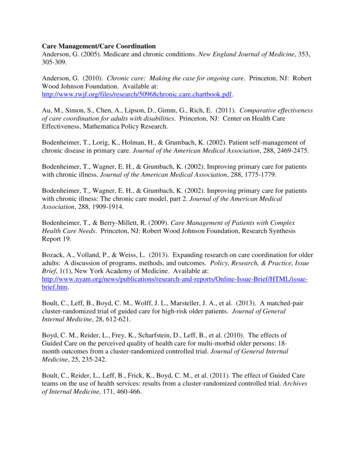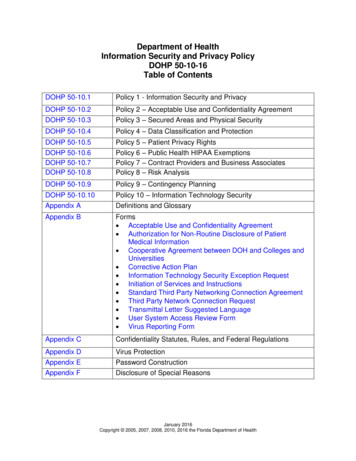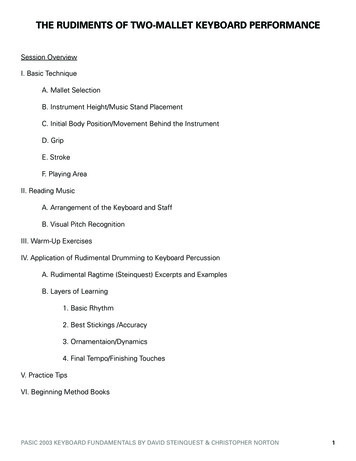
Transcription
Care Management/Care CoordinationAnderson, G. (2005). Medicare and chronic conditions. New England Journal of Medicine, 353,305-309.Anderson, G. (2010). Chronic care: Making the case for ongoing care. Princeton, NJ: RobertWood Johnson Foundation. Available .care.chartbook.pdf.Au, M., Simon, S., Chen, A., Lipson, D., Gimm, G., Rich, E. (2011). Comparative effectivenessof care coordination for adults with disabilities. Princeton, NJ: Center on Health CareEffectiveness, Mathematica Policy Research.Bodenheimer, T., Lorig, K., Holman, H., & Grumbach, K. (2002). Patient self-management ofchronic disease in primary care. Journal of the American Medical Association, 288, 2469-2475.Bodenheimer, T., Wagner, E. H., & Grumbach, K. (2002). Improving primary care for patientswith chronic illness. Journal of the American Medical Association, 288, 1775-1779.Bodenheimer, T., Wagner, E. H., & Grumbach, K. (2002). Improving primary care for patientswith chronic illness: The chronic care model, part 2. Journal of the American MedicalAssociation, 288, 1909-1914.Bodenheimer, T., & Berry-Millett, R. (2009). Care Management of Patients with ComplexHealth Care Needs. Princeton, NJ: Robert Wood Johnson Foundation, Research SynthesisReport 19.Bozack, A., Volland, P., & Weiss, L. (2013). Expanding research on care coordination for olderadults: A discussion of programs, methods, and outcomes. Policy, Research, & Practice, IssueBrief, 1(1), New York Academy of Medicine. Available .Boult, C., Leff, B., Boyd, C. M., Wolff, J. L., Marsteller, J. A., et al. (2013). A matched-paircluster-randomized trial of guided care for high-risk older patients. Journal of GeneralInternal Medicine, 28, 612-621.Boyd, C. M., Reider, L., Frey, K., Scharfstein, D., Leff, B., et al. (2010). The effects ofGuided Care on the perceived quality of health care for multi-morbid older persons: 18month outcomes from a cluster-randomized controlled trial. Journal of General InternalMedicine, 25, 235-242.Boult, C., Reider, L., Leff, B., Frick, K., Boyd, C. M., et al. (2011). The effect of Guided Careteams on the use of health services: results from a cluster-randomized controlled trial. Archivesof Internal Medicine, 171, 460-466.
Boult, C., Green, A., Boult, L., Pacala, J., Snyder, C., & Leff, B. (2009). Successful modelsof comprehensive care for older adults with chronic conditions: Evidence for the Institutes ofMedicine’s “Retooling for an Aging America” report. Journal of the American GeriatricSociety, 57, 2328-2337.Brown, R. (2009). The promise of care coordination: Models that decrease hospitalizationsand improve outcomes for Medicare beneficiaries with chronic illnesses. New York, NY: NewYork Academy of Medicine, Social Work Leadership Institute, National Coalition on CareCoordination.Brown, R. (2009). Strategies for reigning in Medicare spending through delivery systemreforms: Assessing the evidence and opportunities. Menlo Park, CA: The Henry J. KaiserFamily Foundation.Brown, R. S., Peikes, D., Peterson, G., Schore, J., & Razafindrakoto, C. M. (2012). Six featuresof Medicare coordinated care demonstration programs that cut hospital admissions of high riskpatients. Health Affairs, 31, 1156-1166.Congressional Budget Office. (2004). An analysis of the literature on disease managementprograms. Washington, DC: Congressional Budget Office.Congressional Budget Office. (2005). High-cost Medicare beneficiaries. Washington, DC:Congressional Budget Office.Counsell, S. R., Callahan, C. M., Clark, D. O., Tu, W., Buttar, A. B., Stump, T. E., & Ricketts,G. D. (2007). Geriatric care management for low-income seniors: A randomized controlledtrial. Journal of the American Medical Association, 298, 2623-2633.Counsell, S. R., Callahan, C. M., Tu, W., Stump, T. E., Arling, G. W. (2009). Cost analysis ofthe geriatric resources for assessment and care of elders care management intervention. Journalof the American Geriatrics Society, 57, 1420-1426.Dorr, D. A., Wilcox, A. B., Brunker, C. P., Burdon, R. E., & Donnelly, S. M. (2008). The effectof technology-supported, multidisease care management on the mortality and hospitalization ofseniors. Journal of the American Geriatrics Society, 56, 2195-2202.Ferris, T. G., Weil, E., Meyer, G. S., Neagle, M., Heffernan, J. L., & Torchiana, D. F. (2010).Cost savings from managing high-risk patients. In National Research Council, The healthcareimperative: Lowering costs and improving outcomes. Workshop series summary (pp. 301-310).Washington, DC: National Academies Press.Hamblin, A., & Somers, S. A. (2011). Introduction to Medicaid care management bestpractices. Princeton, NJ: Center for Health Care Strategies, Issue Brief.
Jack, B. W., Chetty, V. P., Anthony, D., Greenwald, J. L., Sanchez, G. M., Johnson, A. E.,Forsythe, S. R., et al. (2009). A reengineered hospital discharge program to decreaserehospitalization: A randomized trial. Annals of Internal Medicine, 150, 178-187.Jenks, S. F., Williams, M. V., & Coleman, E. A. (2009). Rehospitalizations among patients inthe Medicare fee-for-service program. The New England Journal of Medicine, 360, 1418-1428.Lorig, K. R., Sobel, D. S., Stewart, A. L., Brown, B. W., Bandura, A., Ritter, P., Gonzalez, V.M., Laurent, D. D., & Holman, H. R. (1999). Evidence suggesting that a chronic disease selfmanagement program can improve health status while reducing hospitalization: A randomizedtrial. Medical Care, 37(1), 5-14.Lorig, K. R., Ritter, P., Stewart, A. L., Sobel, D. S., Brown, B. W., Bandura, A., Gonzalez, V.M., Laurent, D. D., & Holman, H. R. (2001). Chronic disease self-management program: 2year health status and health care utilization outcomes. Medical Care, 39, 1217-1223.McSharry, J., Bishop, F. L., Moss-Morris, R., & Kendrick, T. (2013). ‘The chicken and eggthing’: Cognitive representations and self-management of multimorbidity in people withdiabetes and depression. Psychology & Health, 28(1), 103-119.National Coalition on Care Coordination (2013). Issue brief: Care coordination. Available e-briefs/research:care-coordination-brief/.Nelson, L. (2012). Lessons from Medicare’s demonstration projects on disease managementand care coordination. Washington, D.C.: Congressional Budget Office, Working Paper 201201.Peikes, D., Chen, A., Schore, J., & Brown, R. (2009). Effects of care coordination onhospitalization, quality of care, and health care expenditures among Medicare beneficiaries: 15randomized trials. Journal of the American Medical Association, 301, 603-618.Peikes, D., Peterson, G., Brown, R. S., Graff, S., & Lynch, J. P. (2012a). How changes inWashington University’s Medicare coordinated care demonstration pilot ultimately achievedsavings. Health Affairs, 31, 1216-1226.Scholaski, J., Jaarsma, T., Krumholz, H. M., Laramee, A., McMurray, J. J. V., et al. (2009).What works in chronic care management: The case of heart failure. Health Affairs, 28(1), 179189.Schraeder, C., Shelton, P., & Sager M. (2001). The effects of a collaborative model of primarycare on the mortality and hospital use of community-dwelling older adults. Journal ofGerontology: MEDICAL SCIENCES, 56A(2), M106-M112.Shelton, P., Schraeder, C., Dworak, D., Fraser, C., & Sager M. A. (2001). Caregivers’ utilizationof health services: Results from the Medicare alzheimer’s disease demonstration, Illinois site.Journal of the American Geriatrics Society, 49(12), 1600-1605.
Unutzer, J., Katon, W., Callahan, C. M., Williams, J. W., Hunkeler, E., Harpole, L., et al.(2002). Collaborative care management of late-life depression in the primary care setting: Arandomized controlled trial. Journal of the American Medical Association, 288, 2836-2845.Volland, P. J., Schraeder, C., Shelton, P., & Hess, I. (2013). The transitional care andcomprehensive care coordination debate. Generations, 36(4), 13-19.
Transitional CareColeman, E. A., Smith, J. D., Frank, J. C., Min, S., Parry, C., & Kramer, A. M. (2004).Preparing patients and caregivers to participate in care delivered across settings: The caretransitions intervention. Journal of the American Geriatrics Society, 52, 1817-1825.Coleman, E. A., Parry, C., Chalmers, S., & Min, S. J. (2006). The care transitions intervention:Results of a randomized controlled trial. Archives of Internal Medicine, 166, 1822-1828.Naylor, M. D., Brooten, D., Campbell, R., Jacobsen, B. S., Mezey, M. D., Pauly, M. V., &Schwartz, J. S. (1999). Comprehensive discharge planning and home follow-up of hospitalizedelders: A randomized clinical trial. Journal of the American Medical Association, 281, 613-620.Naylor, M. D., Brooten, D. A., Campbell, R. L., Maislin, G., McCauley, K. M., & Schwartz, J. S.(2004). Transitional care of older adults hospitalized with heart failure: A randomized,controlled trial. Journal of the American Geriatrics Society, 52, 675-684.Naylor, M. D., & Sochalski, J. A. (2010). Scaling up: Bringing the transitional care model intothe mainstream. The Commonwealth Fund, Issue Brief No. 1453. New York, NY: TheCommonwealth Fund.Peikes, D., Lester, R. S., Gilman, B., & Brown, R. (2013). The effects of transitional caremodels on re-admissions: A review of the current evidence. Generations, 36(4), 44-55.Books/Book ChaptersSchraeder, C., & Shelton, P. (Eds.). (2011). Comprehensive Care Coordination for ChronicallyIll Adults. West Sussex, UK: John Wiley & Sons.Schraeder, C., Brunker, C. P., Hess, I., Hale, B. A., Berger, C., & Waldschmidt, V. (2011).Intervention components. In In C. Schraeder & P. Shelton (Eds.), Comprehensive carecoordination for chronically ill adults (pp. 87-126). West Sussex, UK: John Wiley & Sons.Brown, R. S., Ghosh, A., Schraeder, C., & Shelton, P. (2011). Promising practices inacute/primary care. In In C. Schraeder & P. Shelton (Eds.), Comprehensive care coordinationfor chronically ill adults (pp. 39-64). West Sussex, UK: John Wiley & Sons.Gerolamo, A. M., Schore, J., Brown, R. S., & Schraeder, C. (2011). Medicare coordinated care.In In C. Schraeder & P. Shelton (Eds.), Comprehensive care coordination for chronically illadults (pp. 229-259). West Sussex, UK: John Wiley & Sons.
Care Management/Care Coordination Anderson, G. (2005). Medicare and chronic conditions. New England Journal of Medicine, 353, 305-309. Anderson, G. (2010).










